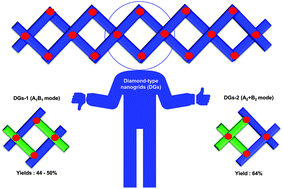Spiro-based diamond-type nanogrids (DGs) via two ways: ‘A1B1’/‘A2 + B2’ type gridization of vertical spiro-based fluorenol synthons†
Abstract
Regular or well-defined nanogrids with atomically precise extension sites offer an opportunity for covalent nano-architectures as well as frameworks. Previously, we discovered organic nanogrids based on the 2,7-linkage of fluorene via Friedel–Crafts gridization. However, the regularity of nanogrids is not always based on the actual molecular backbone, which leads to ineffective linkage for the more regular complex nanogrids such as nano-windows. Herein, we report the introduction of spirobifluorene, which has more orthogonal shapes, to fix the backbone of nanogridons with regards to the diarylfluorenes. The diamond-type nanogridons (DGs) obtained as a result have the potential feature of cross extension, which is different from their ladder-type counterparts, although they both have four well-defined extension sites. In order to screen efficient monogridon modules, we designed two types of DGs (spiro[fluorene-9,8′-indeno[2,1-b]thiophene] (SFIT)-based DGs-1 and spirobifluorene-based DGs-2) and compared their synthetic routes. The results show that the Friedel–Crafts (F–C) gridization of the A1B1 synthon (A1B1 mode) offers DGs-1 in 44–50% yields, while the F–C gridization of A2 + B2 synthons (A2 + B2 mode) is more efficient and gives DGs-2 in 64% yield. Furthermore, unlike in the A1B1 mode, the dehydroxylated byproduct and linear polymers were not observed in the A2 + B2 mode.

- This article is part of the themed collection: Supramolecular chemistry in OBC


 Please wait while we load your content...
Please wait while we load your content...